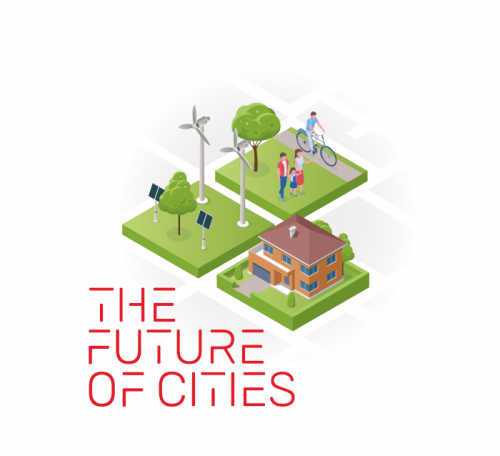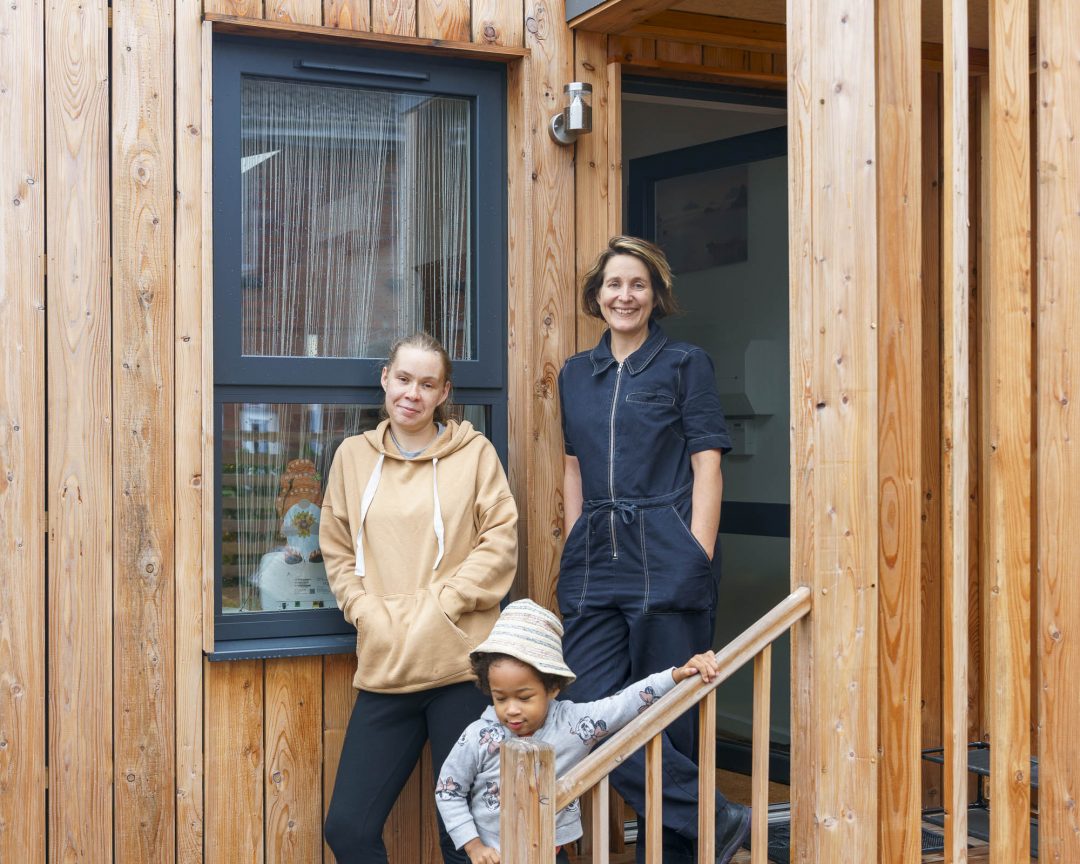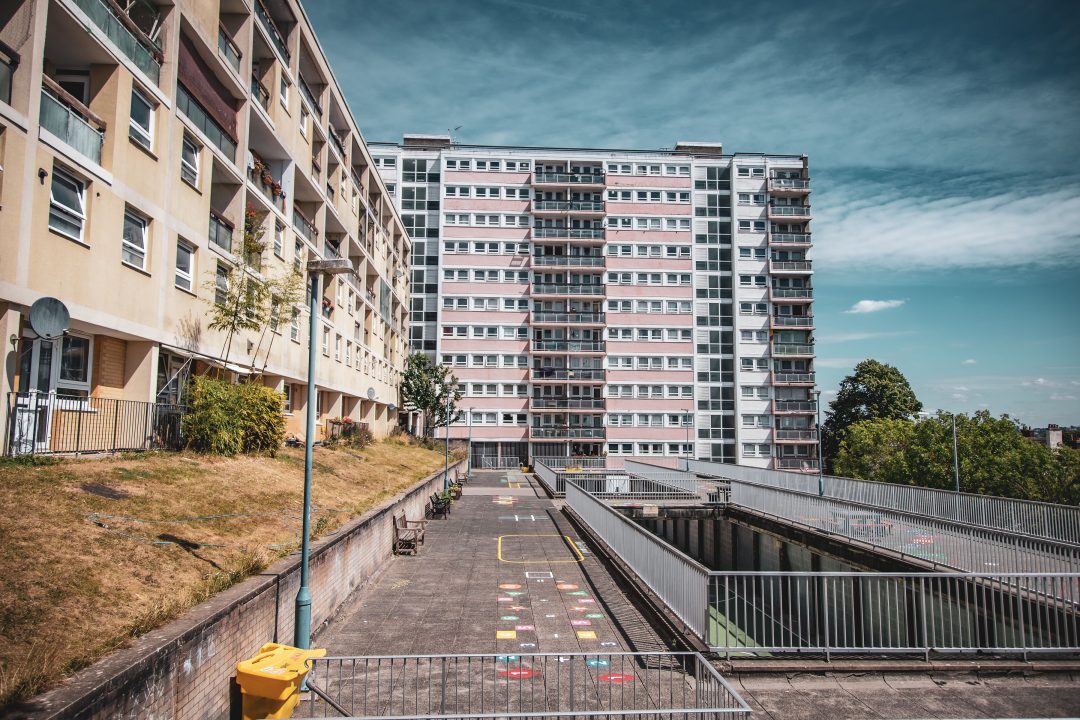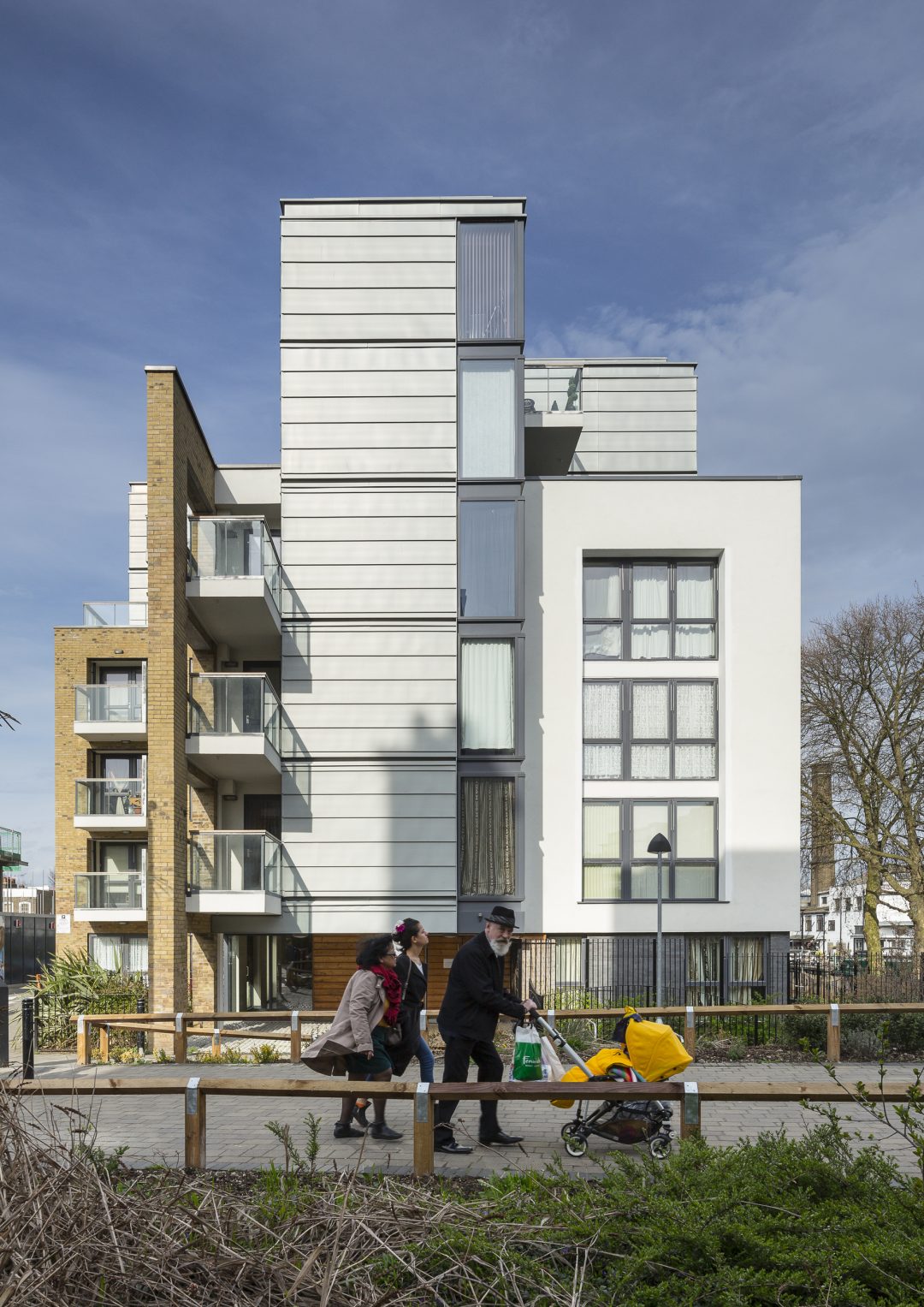

Toni Gray and her three-year-old daughter live in a bungalow in the back garden of her parents’ council house. It was built as part of a radical housing project in south Bristol recognised for its co-design approach.
The 25-year-old, who had been living with her mum and dad while on Bristol City Council’s housing waiting list, had a say on her new home’s size and layout, and helped the building firm put it together before moving in in June.
“We sat in the garden and figured out what we wanted… We drew it up and I had a lot of input in all of it,” Toni tells the Cable. The bungalow has two bedrooms, a bathroom and an open-plan kitchen and living area.
“It’s great because I needed my independence and space, but mum is still close by. It’s much better for the little one.”
Toni’s was the first of two new council homes to be built in people’s gardens in Knowle West – a low-density, 1930s council estate – as part of a pilot run by community interest company We Can Make.
The company, which is now working with the council on plans for 14 more homes, uses a co-design approach to development that it says empowers communities “to do housing on their own terms”.
The lowdown
The problem: Bristol City Council needs to upgrade its housing estates to make them fit for the future. This could mean complete demolition and rebuilding of some blocks. A shrinking budget and a low level of trust in estate regeneration makes this a complex problem for the authority.
The solution: Co-designed projects, where developers work with, rather than for people who live in the homes being rebuilt, is an approach that can help maintain or repair this trust. But can this approach be applied on a mass scale?
Co-design is championed by community-led schemes like We Can Make because – if done right – it can yield powerful results. But they tend to be small projects in neighbourhoods where land exists to build on.
With the demand for council homes growing fast, the local authority is ramping up its house building efforts. But the city’s brownfield sites are limited; meanwhile, some existing council homes are in desperate need of repairs.
Read more

How do we build cities fit for the future? Read more from our year-long series of reporting on solutions to problems faced by Bristol and cities across the world.
A shrinking budget only adds to the complexity of the problem. As does residents’ low level of trust in regeneration, which to some has become a byword for the displacement of communities.
If done right, co-designed projects — where developers work with, rather than for the people who will live in the homes being built or refurbished — is an approach that can help maintain trust with communities, and deliver good-quality homes.
In other cities co-design is crossing into mainstream development and councils are trialling the approach as they attempt to get residents on board with major estate regeneration. So as Bristol City Council considers rebuilding and upgrading its social housing – under plans unveiled in 2020 that have so far failed to get off the ground – can co-design help it create the city’s council estates of the future?
Crunch time for post-war estates
 Melissa Mean, right, with Toni and her three-year-old daughter
Melissa Mean, right, with Toni and her three-year-old daughter
Toni and her parents opted into the We Can Make scheme by volunteering their back garden. The council-owned land was then transferred to a community land trust on a long-term lease, and the plans for the site were drawn up according to an evolving ‘community design code’.
The code is being developed collaboratively with the Knowle West estate’s residents. Its aim is to speed up the process of gaining planning approval, while ensuring the homes being built work for the local neighbourhood.
Melissa Mean, We Can Make’s managing director, says the group’s process of “gentle, opt-in densification”, is about truly understanding community assets and learning what local people can bring to a development.
“With this, we’re able to bring in relationships of trust, understanding… That’s when the real magic of co-design happens,” says Mean. “We held very, very early engagement with the community about what kinds of things are welcome here.”
We definitely need some new ideas… The housing crisis isn’t going to be fixed by ‘business as usual’
The fact Toni has known Mean since she was a child might have helped, too. She went to an after-school music group at Knowle West Media Centre (KWMC), where Mean is head of arts and where We Can Make is based.
“Toni has grown up with the media centre, and she’s been involved every step of the way,” Mean says. “She has been to all the workshops, worked with architects on the design of her home, right through to self-finish. She’s really proud.”
“Communities can feel a bit under siege with a development just kind of put to them,” Mean says. “Generally, they get asked to be involved quite late in a process and it can feel a bit like a tick-box exercise.”
“What’s different here is we’re asking things as a community and trying things out,” she adds. “Because of the scale of the [housing] crisis, we’ve got to try new ways of doing stuff.”
But the scale of We Can Make is dwarfed by the number of people living in social housing in need of repairs, or still stuck on the waiting list. Almost 18,500 people are on Bristol City Council’s housing waiting list, and more than 1,000 are in temporary accommodation waiting for somewhere suitable to live.
 Bristol’s Dove Street flats, which are among the estates that need modernising
Bristol’s Dove Street flats, which are among the estates that need modernising
Under Bristol City Council’s ‘Project 1000’ initiative, it’s aiming to build 1,000 affordable homes a year by 2024. The majority of homes in the newbuild programme are on brownfield and derelict sites.
The local authority’s attention, however, is also turning to its existing estates.
The council owns 28,000 properties, including 62 high-rises and 450 low-rise blocks. The scale of the challenge to maintain and modernise this council housing so it’s fit for the future, while getting residents on board, is huge.
It has been criticised over poor conditions of some of its housing, such as a sheltered housing block in Hartcliffe, Walwyn Gardens, where tenants have complained of freezing conditions and damp.
A report published earlier this year says £2.7m of upgrades will start at Walwyn soon and highlights how maintaining its large portfolio is a “significant challenge”, exacerbated by rising construction costs. It identifies a list of more than a dozen estates where major work is required.
Under plans for an “ambitious estate regeneration” programme unveiled in 2020, the council said it would identify estates most urgently in need of regeneration to make them low carbon, low energy and safe. Some homes could be demolished, it said at the time.
Since then, while some estates that were deemed to be among the poorest-performing have had external upgrades carried out, the programme hasn’t got off the ground.
In fact, the council hasn’t embarked on a major housing estate regeneration project for two decades.
Tom Renhard, the authority’s cabinet member for housing, turned down several requests to be interviewed for this article. But speaking to the Cable last summer, he did not rule out housing being razed and rebuilt as the local authority grapples with how to improve its homes.
Restating a promise made by his predecessor Paul Smith, he said council tenants would be fully consulted on any proposals, including having a veto over whether homes are demolished.
Renard was clear he supported a co-design approach to regeneration, but no commitment was made. “We’re trying to bring communities with us,” he said. “That might mean taking a bit longer to get it right, and do something the majority of people are happy with, but ensuring that we go through a co-design process is more important to me.”
Involving residents in major regeneration schemes might feel like a mammoth task. But there are tried and tested examples of how to go about scaling up co-design across an entire estate. Bristol could look to projects such as north London’s award-winning Packington Estate, which involved existing residents in its major rebuild.
‘People live on these estates, they know what works’
In 2003, Jan Durbridge returned from holiday to a letter explaining her flat on the Packington Estate was structurally unsafe and facing demolition. The estate, near Angel, was built in the 1970s by Islington Council using the same construction method as Ronan Point, an east London tower block that partially collapsed after a gas explosion, killing four people.
With buildings ruled unsafe, residents had two options: strengthen the existing buildings or demolish all 538 homes and rebuild them, in addition to 300 new private units. The estate’s tenants and leaseholders formed the Packington Reference Group (PRG) and took the “unanimous decision to pull it down”, says Durbridge.
But to pay for the rebuild, Islington Council had to transfer the estate to new owners. So the PRG met with interested landlords and drew up a wishlist of improvements. “Old Packington had been described as a sink estate. I don’t think it was, but it certainly had problems,” Durbridge recalls.
It’s very arrogant that people think they know what’s best for you
Jan Durbridge, The Packington Estate
The old estate’s inward-looking layout encouraged anti-social behaviour, which meant a top ask from residents was to reinstate the site’s original Victorian street pattern. Tenants asked for the prioritisation of social housing over the 300 private homes cross-subsidising the scheme. Traditional brick and block construction, spacious flats and balconies that could accommodate a table were also on the wishlist.
“The residents didn’t want to get shipped up to the north end of the site next to the road,” explains Kaye Stout, the architect at Pollard Thomas Edwards (PTE) who led the regeneration’s design from 2009. “Our team said the first phase is next to the canal, let’s put all the residents there because, frankly, that will mean we will win.”
 London’s Packington Estate, which involved existing residents in a major rebuild
London’s Packington Estate, which involved existing residents in a major rebuild
Not all the bidders were so astute. The selection day was “illuminating”, recalls Durbridge, with residents taken aback at a proposal to put a fake canal through the centre of the site and another that squeezed in so many homes the blocks were almost touching. “What they presented made you wonder if they had been in the same room as you.”
Ultimately, large housing association Hyde and PTE won the contract, and they set up a shadow estate board with a design sub group. It took 12 years to build, eventually completing in 2019. While not everything on the wishlist made it through, on the “big things” Hyde delivered, Durbridge says.
The term ‘co-design’ was not used at the time but was there in all but name, says Stout, whose practice PTE has used the approach since the 1970s. The architect stressed how as well as being “fierce” campaigners, Packington residents were ahead of their time. Most of their demands would later appear in the London’s Housing Design Guide, a blueprint first introduced in 2010 for new homes across the capital.
Other factors played into its success. The scheme started before the era of austerity kicked in, with Hyde able to access £33m in central government “gap” funding to kickstart the project. Its affluent location also meant the private homes would fetch huge prices, though one of its many awards praises Hyde for resisting the “temptation to capitalise more than necessary”.
Packington’s status as an estate in transition between owners also played its part, presenting a rare opportunity for residents to step in and influence the scheme’s direction. Councils will usually take decisions privately on how many homes a regeneration will include, and which type of housing should occupy the site’s prime land, as these factors directly impact on a scheme’s financial viability.
Packington’s results are testament to what can be done if residents are allowed into the process. As Durbridge says: “People live on these estates, they know what works and what doesn’t work. It’s very arrogant that people think they know what’s best for you.”
Right wrongs, repair trust
From Blair to Cameron, over the past few decades politicians of all stripes zoned in on housing estates as symbols of wider societal problems, blaming modernist architecture for “designing in” poverty and crime.
But the regeneration schemes of the noughties did not deliver on bold promises of renewal. Instead, estates across the UK became battlegrounds, with higher land value cities like London some of the worst affected.
The Heygate Estate in south London was formerly home to around 3,000 residents before they were “decanted” and the buildings demolished, a cautionary tale for how destructive regeneration can be. It wasn’t just estates either, as private terraced houses across the North and the Midlands were bought up and demolished under the controversial “pathfinder” initiative.
Awareness about the marginalisation of council tenants’ voices has grown since the 2017 Grenfell Fire saw residents’ repeated fire safety warnings ignored.
Against this backdrop, councils’ use of co-design as a regeneration ‘tool’ is rising, suggesting an effort to right past wrongs and repair trust. But experts fear co-design is sometimes used as lip-service to resident engagement.
“It’s become a buzzword,” says Hana Loftus, an architect and planner with extensive co-design expertise. “Ultimately, it’s not handing over or sharing power that meaningfully.”
Reporting on the stories that matter to you. Only with your support.
Join now
A co-design approach fits naturally with the UK’s community-led housing sector. One example is Bristol Community Land Trust’s 12-home Fishponds Road project where residents even completed the homes’ fit-outs themselves. Its second larger project in Lockleaze adopts a similar “self-finish” approach.
Finding completed co-designed estate projects is tougher, but Anglo-Swedish architect Ralph Erskine’s pioneering Byker Wall estate in Newcastle stands out. Built to replace Victorian back-to-back terraces in the 1970s, Byker is famous among modern architecture aficionados for its striking 1.3 mile spine of brightly coloured maisonettes. Equally important, as Historic England notes in its Grade II listing, the estate took a “pioneering … approach to public participation”.
Yet, the original plan for residents to return wasn’t fully realised.
There are many reasons co-design on large social housing projects is hard, Loftus says. Among them are local politics, a lack of resources, and disillusionment from previous, failed regeneration attempts. The most fundamental, perhaps, is reconciling responsibilities to existing tenants and to building homes for the thousands of people sitting on council waiting lists, or in overcrowded temporary accommodation.
North London’s Barnet Council tried out co-design on their Fosters Estate after a bruising experience at another estate that culminated in residents accusing the local authority of “social cleansing” on TV.
Loftus was hired to lead the two-year co-design process and residents helped shape the scheme with the architect, pushing to retain the estate’s “park-like” feel. However, the council “lost its nerve” when the plans attracted over 200 objections, and after it was approved Barnet did not renew Loftus’ contract.
This is common on co-designed estate projects, when the client doesn’t get the outcome they are hoping for, says Loftus. “They feel – we’ve done loads of really great engagement with our residents. So why are they still unhappy?”
Yet Loftus says this misses the point of co-design, which is to get the best design solution possible through involving residents, rather than making “everyone agree”.
Barnet Council said it was committed to maintaining a strong community on Fosters Estate and it had “learned a lot” from its co-design process. It added that its masterplan “demonstrates the value of putting residents at the heart of decision making”.
‘A process of empowerment’
Experimental projects like We Can Make in Knowle West and London’s Packington Estate show that working with local people can build trust and housing fit for the future. Loftus describes how at its best co-design can deliver more than that, becoming a “process of empowerment”.
“Communities have a huge amount of know-how and creativity, and we’ve got to better tap into that,” says Mean, whose We Can Make project is expecting to build another four council homes in Knowle West by next spring. “That’s where new ideas are going to come from. And we definitely need some new ideas… The housing crisis isn’t going to be fixed by ‘business as usual’.”
Scaling co-design up from Bristol’s micro-sites to an estate with hundreds or even thousands of residents would be a challenge. But standing at the beginning of its new estate regeneration chapter, with a wealth of local knowledge and expertise to draw on, Bristol City Council has a chance to rewrite the rulebook.
How can I take action?
- Read more stories from our brand new Future of Cities series, and sign up to our newsletter to get the next instalment straight to your inbox
- Learn how to co-design council estates of the future: A short film, playbook and podcasts will explain the ins and outs of We Can Make’s community design code and their journey so far.
- Join our discussion forum: Are you involved in housing in some way? Share your knowledge and shape the direction of our future coverage of solutions to the housing crisis.
Request to join it by emailing: [email protected] - Share this with local politicians: Councillors have a leading role in turning ideas into political action, so get in touch with them and use your democratic voice! The more people who read this story, the greater the chance it’ll have an impact. Share it!
- Have your say in the comments below.
The Future of Cities project is funded by the European Journalism Centre’s Solutions Journalism Accelerator, supported by the Bill & Melinda Gates Foundation.
https://news.google.com/__i/rss/rd/articles/CBMihgFodHRwczovL3RoZWJyaXN0b2xjYWJsZS5vcmcvMjAyMi8xMC9mdXR1cmUtb2YtY2l0aWVzLWhvdXNpbmctc29sdXRpb25zLXJldGhpbmtpbmctcmVnZW5lcmF0aW9uLWNvdWxkLWNvLWRlc2lnbi10cmFuc2Zvcm0tY2l0eS1lc3RhdGVzL9IBAA?oc=5





